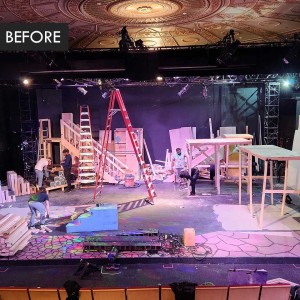Loading…
Recent Posts
Learn How Community Forklift Helped Bring a Gala Theatre Set to Life
Learn How Community Forklift Helped Bring a Gala Theatre Set to Life
By Community Forklift, originally published on Community Forklift’s blog
Community Forklift provided the backdrop for exciting programming and shows from GALA Theatre, one of the most vibrant arts groups in the Washington, DC area.
GALA (Grupo de Artistas LatinoAmericanos) Hispanic Theatre is a National Center for Latino Performing Arts group located right in Washington, DC. This group brings Latino arts to audiences who are both steeped in the culture as well as those who are experiencing the beauty and diversity of Hispanic heritage for the first time. Live theater, dance, and musical productions are performed in both Spanish and English, and GALA Theatre provides the space and expertise for education and enrichment in addition to entertainment.
But putting on these impressive shows and programming can be costly. Often, we think of the lighting, venue, advertising, staff, and other large expenses when it comes to running a theater company, but the cost of the set itself can be significant.
That’s why GALA applied to Community Forklift’s Community Building Blocks (CBB) program. This grant allowed them to bring their set to life for programs, plays, GALita children’s plays, ArteAmerica programs, and PasoNuevo youth performances. One of the highlights of the season was using Community Forklift finds to showcase the vibrancy, color, and provenance of their February 2024 show, Las Hermana Palacios (The Palacios Sisters).

The set for GALA’s most recent production “Mummy in the Closet: Evita’s Return” incorporates salvaged 4x4s, light fixtures, molding, and more from Community Forklift.
Materials sourced from Community Forklift added detail and authenticity to the set. Everything from wall sconces to trim, doors, hardware, floor tiles, sliding glass doors, paint, and lamps were used to breathe life into the stage. These real pieces made the on-stage scenery tangible for the audience and brought a quality of dynamism to the production. And these pieces aren’t just used once — they can be used year-after-year, reimagined for each season’s productions.

“Mummy in the Closet: Evita’s Return” is a musical blending history and fantasy. It follows the afterlife of Eva Peron, when her preserved corpse ignites political scandals and clandestine affairs.
The partnership between GALA and Community Forklift was initially borne out of the company looking to Community Forklift as a resource for affordable secondhand finds for the set. With the encouragement of the Community Forklift staff, GALA applied for a CBB grant and was accepted. Since 2011, over 500 other organizations across the area have received over $500,000 worth of materials.
Through our Community Building Blocks (CBB) program, we provide mini-grants that allow community groups and nonprofits to use warehouse credit towards a wide range of projects that serve the greater community. That could be furniture for an elementary school teacher’s lounge in an underserved neighborhood or necessary appliances for a facility that works with providing resources to the unhoused community.
Community Forklift turns the construction waste stream into a resource steam for communities in the DC region — by keeping perfectly good items out of the landfill, preserving historical materials, providing low-cost building supplies, and creating local green jobs. Learn more and support them by donating or shopping. Organizations interested in applying for a CBB grant can connect with them to find out more.
- Announcing Spur Local’s 2024 Nonprofit Class Leave a reply
- Change a Child’s Story with Court Appointed Special Advocate (CASA)/Prince George’s County Leave a reply
- Planning for Peace with Peace of Mind Leave a reply
- We Strengthen Communities by Investing in People Leave a reply
- Embracing Healing as a Joyous Experience with Ronald McDonald House Charities of Greater Washington, DC Leave a reply
- “Mother Power” Half a Century Later, with the Mother’s Outreach Network Leave a reply
- Finding Your Community with Loudoun Cares Leave a reply
- A Place of Belonging with BroadFutures Leave a reply
- Quality, Accessible Health Care for the Whole Family with Ronald McDonald House Charities of Greater Washington, DC Leave a reply
